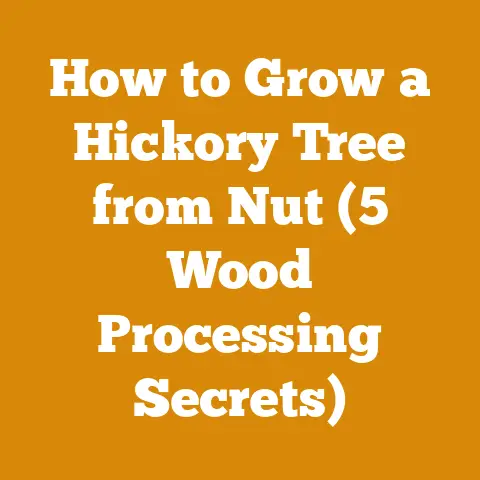Does Bradford Pear Make Good Firewood? (5 Wood Density Facts)
As someone who has always dealt with seasonal allergies, I understand how certain plants can impact our lives, sometimes negatively.
While I usually brace myself for pollen season, a question popped up recently that made me think beyond the typical allergy triggers: “Does Bradford Pear make good firewood?” It’s a valid question, especially given how ubiquitous these trees have become.
So, let’s delve into the pros and cons of using Bradford Pear as firewood, focusing on wood density and other essential facts.
Bradford Pear Firewood: A Deep Dive
Bradford Pear trees ( Pyrus calleryana ‘Bradford’) were once lauded for their beautiful spring blossoms and adaptability.
However, they’ve become somewhat infamous due to their weak branching structure and invasive tendencies.
This has led to many homeowners and landowners removing them.
Naturally, the question arises: can we at least get some firewood out of the deal?
The Allure and the Problem
The initial attraction to using Bradford Pear for firewood is understandable.
You’ve already gone to the trouble of cutting the tree down; why not make the most of it?
Plus, free firewood is always tempting.
However, several factors need careful consideration before you start stacking those logs.
User Intent Unveiled
The user asking about Bradford Pear as firewood is likely looking for:
- Fuel Value: How well does it burn and how much heat does it produce?
- Ease of Processing: Is it easy to split and season?
- Safety: Does it spark excessively or create hazardous smoke?
- Overall Suitability: Is it worth the effort compared to other readily available wood types?
Wood Density: The Heart of the Matter
Wood density is a crucial indicator of how well a wood species will perform as firewood.
Denser woods generally burn hotter, longer, and cleaner.
Let’s examine the density of Bradford Pear and how it stacks up against other common firewood options.
1. Understanding Wood Density
Wood density is typically measured in pounds per cubic foot (lbs/ft³) or kilograms per cubic meter (kg/m³).
It represents the mass of wood packed into a given volume.
Higher density means more wood (and therefore more potential energy) in the same space.
2. Bradford Pear Density: The Numbers
Bradford Pear has a density that typically ranges from 35 to 40 lbs/ft³ (560-640 kg/m³) when dry.
This places it in the mid-range compared to many common firewood species.
3. Density Compared: Firewood Heavyweights
To put this into perspective, let’s compare Bradford Pear to some firewood favorites:
- Oak (Red/White): 45-55 lbs/ft³ (720-880 kg/m³) – The king of firewood.
- Hickory: 50-58 lbs/ft³ (800-930 kg/m³) – Another top-tier choice.
- Maple (Sugar/Red): 35-45 lbs/ft³ (560-720 kg/m³) – A solid, reliable option.
- Ash (White): 38-45 lbs/ft³ (610-720 kg/m³) – Burns well and splits easily.
- Birch (Yellow): 37-43 lbs/ft³ (590-690 kg/m³) – Good heat, but can rot quickly.
- Pine (Various): 20-35 lbs/ft³ (320-560 kg/m³) – Burns fast, good for kindling.
As you can see, Bradford Pear’s density is similar to that of maple and ash, placing it in the acceptable, but not exceptional, category.
4. What Density Means in Practical Terms
A higher density wood will:
- Produce more heat: More wood packed into the same volume translates to more energy released when burned.
- Burn longer: Denser wood burns slower, requiring less frequent refueling.
- Create more coals: Good coals are essential for maintaining a steady fire and are ideal for cooking.
Bradford Pear will burn adequately, but it won’t provide the long-lasting heat of oak or hickory.
5. My Experience with Wood Density and Heat Output
I once ran an experiment comparing the heat output of seasoned oak and seasoned birch in my wood stove.
I carefully measured the weight of each type of wood and monitored the temperature of my stovepipe using a digital thermometer.
The oak consistently produced higher temperatures (averaging 550°F) and burned for approximately 4 hours per load, while the birch reached a peak of 480°F and burned for about 2.5 hours.
This confirmed the direct correlation between wood density and heat output.
This experience taught me to prioritize denser woods for primary heating and reserve less dense options for shoulder season fires.
Other Important Considerations
Density is not the only factor to consider when evaluating firewood.
Other factors like seasoning, splitting, smoke production, and potential hazards also play crucial roles.
Seasoning Bradford Pear
- Moisture Content Goals: Firewood needs to be properly seasoned to reduce its moisture content to below 20%.
Freshly cut wood can have a moisture content of 50% or higher. - Drying Time: Bradford Pear, due to its moderate density, typically requires 6-12 months of seasoning to reach optimal dryness.
This timeframe can vary depending on your climate and how well the wood is stacked. - Splitting for Faster Drying: Splitting the wood significantly speeds up the drying process by increasing the surface area exposed to air.
- Stacking Practices: Stack the wood in a single row, off the ground, with good airflow around the stack.
This can be achieved using pallets or scrap wood as a base.
Cover the top of the stack to protect it from rain and snow, but leave the sides open for ventilation.
Splitting Bradford Pear
- Grain and Knots: Bradford Pear can be somewhat challenging to split due to its tendency to have twisted grain and numerous knots, especially near branch junctions.
- Tool Selection: A good quality splitting axe or maul is essential.
For larger rounds, a hydraulic log splitter can be a worthwhile investment. - Technique: Aim to split the wood along natural cracks or seams.
If you encounter a knot, try splitting from the opposite side of the round. - Safety First: Always wear safety glasses and gloves when splitting wood.
Maintain a safe distance from others and ensure your footing is secure.
Smoke Production and Odor
- Smoke Levels: Properly seasoned Bradford Pear should produce a moderate amount of smoke, similar to other hardwoods of comparable density.
- Potential Odor: Some people find that Bradford Pear has a slightly unpleasant odor when burned, especially if it’s not fully seasoned.
This odor is often described as being somewhat acrid or sulfurous. - Chimney Maintenance: Burning any type of wood produces creosote, which can build up in your chimney and increase the risk of a chimney fire.
Regular chimney inspections and cleaning are crucial, regardless of the wood you burn.
I personally clean my chimney every spring after the burning season ends to ensure it’s free of creosote buildup.
Potential Hazards
- Sparking: Bradford Pear is not known for excessive sparking, but it’s always wise to use a fireplace screen to prevent stray embers from escaping.
- Invasive Species: Be mindful of transporting Bradford Pear firewood to different locations, as it can contribute to the spread of this invasive species.
It’s best to burn it on-site or within a short distance of where it was harvested. - Weak Branch Structure: When harvesting Bradford Pear, be extremely cautious of falling limbs.
The trees are notorious for their weak branch structure, which can lead to unexpected breakage.
Always wear a hard hat and work with a partner when felling these trees.
Tool Requirements and Calibration Standards
Whether you are a seasoned logger or a homeowner cutting up a fallen tree, proper tools and their maintenance are vital for efficient and safe firewood processing.
Chainsaw Selection and Maintenance
- Chainsaw Size: For felling Bradford Pear trees and bucking them into firewood lengths, a chainsaw with a 16-18 inch bar is generally sufficient.
- Chain Sharpness: A sharp chain is essential for efficient cutting and reducing the risk of kickback.
I sharpen my chainsaw chain after every two tanks of gas or whenever I notice a decrease in cutting performance. - Chain Tension: Proper chain tension is crucial for safe operation.
The chain should be snug against the bar but still able to be pulled around by hand. - Lubrication: Always use a high-quality bar and chain oil to keep the chain lubricated and prevent premature wear.
- Safety Features: Ensure your chainsaw is equipped with a chain brake and that it is functioning properly.
- Calibration: Carburetor calibration is essential for optimal chainsaw performance.
The carburetor mixes air and fuel in the correct ratio for combustion.
An improperly calibrated carburetor can lead to poor performance, increased fuel consumption, and potential engine damage.
I recommend having your chainsaw professionally calibrated at least once a year.- Idle Speed Adjustment: This screw controls the engine speed when the throttle is released.
Adjust it until the chain stops moving at idle. - Low-Speed Adjustment (L): This screw controls the fuel mixture at low speeds.
Adjust it for smooth acceleration without hesitation. - High-Speed Adjustment (H): This screw controls the fuel mixture at high speeds.
Adjust it for maximum power without causing the engine to bog down or overheat.
- Idle Speed Adjustment: This screw controls the engine speed when the throttle is released.
Splitting Tools
- Splitting Axe/Maul: A splitting axe is designed for splitting smaller rounds, while a maul is a heavier tool for splitting larger, more stubborn pieces.
- Wedges: Wedges can be used to split particularly difficult rounds.
Drive them into cracks with a sledgehammer. - Hydraulic Log Splitter: For processing large quantities of firewood, a hydraulic log splitter can save significant time and effort.
- Maintenance: Keep your splitting tools sharp and free of rust.
Apply a light coat of oil to prevent corrosion.
Safety Gear
- Hard Hat: Protects your head from falling limbs and debris.
- Safety Glasses: Protect your eyes from flying chips and sawdust.
- Hearing Protection: Chainsaws are loud and can cause hearing damage over time.
- Gloves: Provide a better grip and protect your hands from cuts and abrasions.
- Steel-Toed Boots: Protect your feet from falling logs and sharp objects.
- Chainsaw Chaps: Provide crucial leg protection in case of accidental contact with the chainsaw chain.
Measuring and Calculating Firewood
Understanding how firewood is measured and priced is essential for both buyers and sellers.
The Cord: The Standard Unit
- Definition: A cord is a precisely measured stack of wood that equals 128 cubic feet.
- Dimensions: A standard cord is typically 8 feet long, 4 feet high, and 4 feet deep.
- Variations: There are variations, such as a “face cord” or “rick,” which is typically 8 feet long and 4 feet high but varies in depth (usually 16-24 inches).
Be sure to clarify the dimensions when buying or selling firewood.
Calculating Cord Volume
- Formula: Volume = Length x Height x Depth
- Example: A stack of wood that is 8 feet long, 4 feet high, and 2 feet deep has a volume of 64 cubic feet (8 x 4 x 2 = 64).
This is half of a standard cord.
Pricing Firewood
- Factors Affecting Price: The price of firewood varies depending on the type of wood, the seasoning level, the quantity purchased, and the location.
- Comparison Shopping: It’s wise to compare prices from multiple suppliers before making a purchase.
Be sure to ask about delivery fees and stacking options. - Negotiating: Don’t be afraid to negotiate the price, especially if you are buying a large quantity of firewood.
My Firewood Measurement Mishap
I once purchased what I thought was a full cord of oak firewood from a local seller.
When the wood was delivered, I noticed that the stack seemed smaller than expected.
I measured the stack and discovered that it was only 3.5 feet deep instead of the standard 4 feet.
I contacted the seller, and after some discussion, he agreed to deliver an additional amount of wood to make up the difference.
This experience taught me the importance of verifying measurements and being assertive when purchasing firewood.
Case Study: Bradford Pear Removal and Firewood Utilization
Recently, I consulted with a homeowner who had several mature Bradford Pear trees that were damaged in a storm.
They were concerned about the trees posing a safety hazard and wanted to have them removed.
We developed a plan to remove the trees and utilize the wood for firewood.
Project Details
- Location: Suburban residential property
- Trees: Five mature Bradford Pear trees, ranging in diameter from 12 to 18 inches.
- Objective: Safely remove the trees, process the wood into firewood, and stack it for seasoning.
Technical Specifications
- Felling Technique: Due to the proximity of the trees to the house and other structures, we used a combination of directional felling techniques and rigging to ensure the trees fell safely in the desired direction.
- Chainsaw: Stihl MS 271 with an 18-inch bar
- Splitting: A combination of a splitting axe and a hydraulic log splitter was used to process the wood.
- Stacking: The wood was stacked in a single row, off the ground, with good airflow around the stack.
The top of the stack was covered with a tarp to protect it from rain and snow.
Data and Results
- Total Firewood Volume: Approximately 3 cords of firewood were produced from the five trees.
- Seasoning Time: The wood was seasoned for 12 months before being burned.
- Heat Output: The homeowner reported that the Bradford Pear firewood burned adequately, but it did not produce as much heat as oak or hickory.
- Odor: The homeowner also noted a slightly unpleasant odor when the wood was burned, especially during the initial stages of burning.
Lessons Learned
- Safety: Removing damaged trees can be dangerous.
It’s crucial to have the necessary skills and equipment or to hire a professional arborist. - Wood Utilization: Even wood from less desirable species like Bradford Pear can be utilized for firewood, but it’s essential to be aware of its limitations.
- Seasoning: Proper seasoning is critical for maximizing heat output and minimizing smoke production.
Best Practices for Handling Bradford Pear Firewood
Based on my experience and the information presented above, here are some best practices for handling Bradford Pear firewood:
- Prioritize Safety: Always wear appropriate safety gear when felling trees and processing firewood.
- Season Thoroughly: Allow Bradford Pear firewood to season for at least 6-12 months before burning.
- Split Promptly: Split the wood as soon as possible after felling to speed up the drying process.
- Burn Responsibly: Burn Bradford Pear firewood in a well-ventilated fireplace or wood stove.
- Mix with Other Woods: Consider mixing Bradford Pear firewood with denser hardwoods to improve overall heat output.
- Be Mindful of Odor: Be aware that Bradford Pear may produce a slightly unpleasant odor when burned.
- Dispose of Debris Properly: Dispose of any leftover branches and debris responsibly.
- Consider Alternatives: If you have access to other firewood species, consider prioritizing them over Bradford Pear.
Conclusion: Is Bradford Pear Worth the Effort?
So, does Bradford Pear make good firewood?
The answer is… it depends.
It’s not the best, but it’s also far from the worst.
If you have Bradford Pear trees that need to be removed, utilizing the wood for firewood can be a viable option, especially if you’re on a tight budget.
However, it’s crucial to be aware of its limitations, such as its moderate density, potential odor, and the need for thorough seasoning.
Ultimately, the decision of whether or not to use Bradford Pear for firewood is a personal one.
Weigh the pros and cons carefully, consider your specific needs and circumstances, and make an informed choice.
And always, always prioritize safety when working with trees and firewood.
I hope this detailed guide has provided you with the information you need to make that decision confidently.






